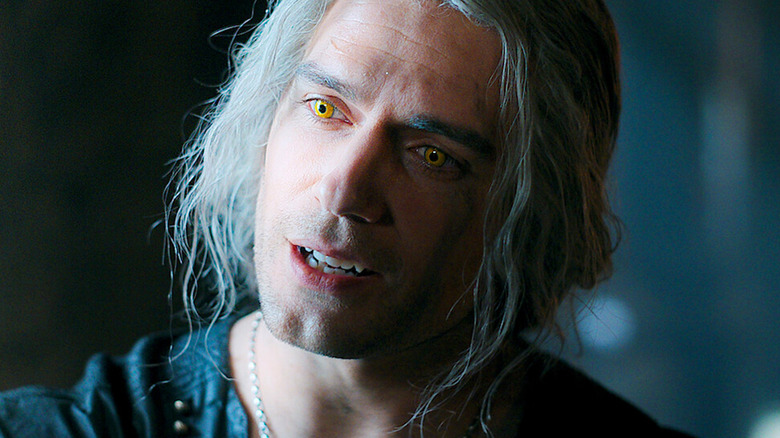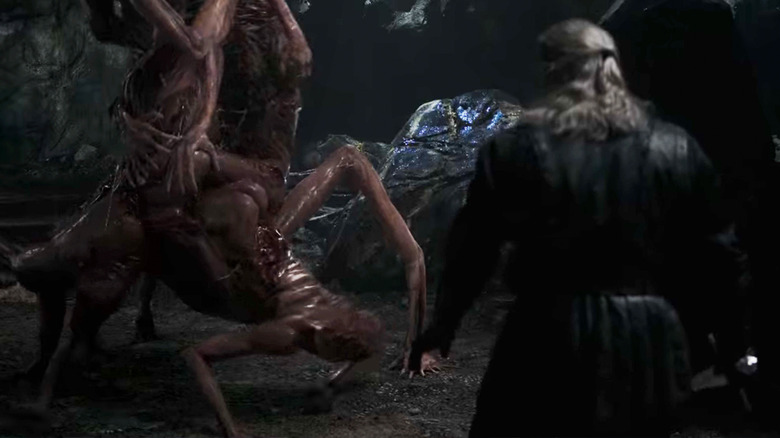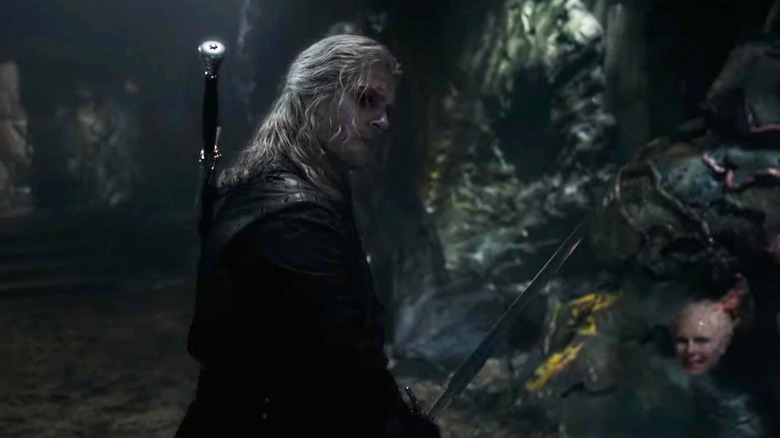The Witcher Season 3 Introduces The Series' Most Tragic And Terrifying Monster Yet
There's a lot you need to remember to understand what's going on in "The Witcher" season 3. The show is no longer just about Henry Cavill's Geralt of Rivia slaying various eldritch beasts. At this point, when "The Witcher" isn't trying to explain its complex lore by way of convoluted exposition, it's trying to tell the tale of Geralt's shift from stoic neutrality to passionate defender of his charge, Ciri.
But that doesn't mean there's absolutely no room for some good old-fashioned monster hunting. While season 3 is much more focused on narrative, The Continent is still awash with horrifying creatures ready to be cut down by the White Wolf. Since the memorable opening sequence in the very first episode of "The Witcher" where Geralt slays the giant Kikimora, the show has delivered all manner of unsettling monstrosities, often providing some sort of back story that makes the beast in question that much worse.
The Striga, for example, is one of the more upsetting abominations Geralt has faced thus far. Back in season 1, the Witcher encountered this cursed product of incest akin to The Mother in "Barbarian," which had ripped its way out of its mother's womb only to stalk the kingdom of Temeria after dark, complete with a still-dangling umbilical cord. In that instance, the White Wolf endured an arduous battle in order to lift the curse and restore the monster to her human form. But for season 3, the "Witcher" writers might just have outdone themselves in terms of monsters with horrifying backstories.
The worst monster yet
Season 3 of "The Witcher" marks Henry Cavill's last go round as Geralt of Rivia. The "Man of Steel" star will bow out after this season to make way for Liam Hemsworth's take on the character. And according to showrunner Lauren Schmidt Hissrich, Cavill will get a heroic send-off at the end of this current season — as he should, considering the threats he's faced this time around.
While season 3 might be more focused on narrative than plain old monster hunting, in episode 2, "Unbound," Geralt's pursuit of Rience leads him to stumble across an abandoned castle. And of course, the fearless monster hunter ventures inside, downing some potion to enhance his eyesight as soon as he recognizes this creepy location could easily play host to some nefarious elements.
But he probably wasn't prepared for a giant flesh monster made up of young girls taken from Aretuza. This twisted beast reveals itself in the dungeon of the castle after Geralt walks past the disembodied heads of several girls protruding from the dungeon walls, still cognizant of everything that's going on. As Geralt faces off against the horrific creature, the heads apparently feel the pain of every slice from his blade as they beg him to stop hurting them, which means the young lady's bodies have been used to construct this hellish creation while their heads have, for some reason, been kept completely conscious to witness the horror. Told you it was worse than the Striga. And as you might expect, conceiving how best to render this nightmarish vision was a challenge.
Making sense of the flesh monster
Head of Franchise Design on "The Witcher," Andrew Laws, spoke to Digital Spy about the difficulty that came with designing the dungeon-dwelling flesh monster, explaining how its unusual genesis threw up some very specific problems. Unlike the Leshen from season 2, which were basically giant tree monsters, or the giant Chernobog that was essentially just a flying hulk of a thing, this monster was unprecedented in the sense it was made up of other bodies. As Laws explained:
"We had to deal with the dynamism of it — very much between prosthetics, creature concept design and VFX — and try to figure out how to evolve this thing and make sense out of it. Because it's not a singular entity that is ... you know, does it have four legs? Does it have two legs? Does it stand up? Does it wave its arms? Does it have magic?"
The end result certainly looks like a lot of CGI was used, and not the most convincing kind. But, in a way, that's not that big a deal as the pure horror of the situation is enough to make it one of the more memorable and downright disturbing scenes from a show that specializes in ungodly monstrosities.


